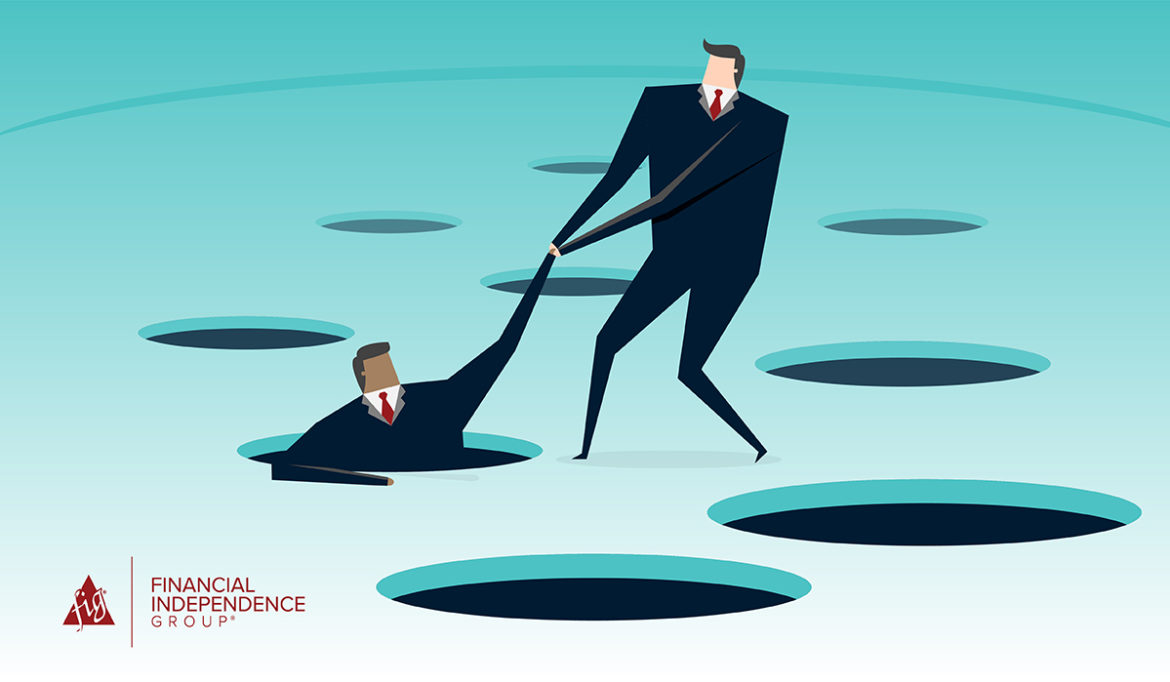Updated September 7, 2023, at 11:40 AM
The decade between 2009 to 2019 marked a ten-year market bull run. It was almost felt like investment mistakes disappeared for a while. What felt like an endlessly growing economy gave investors confidence and assurances that markets aren’t designed to provide. A global pandemic brought on a rude awakening in 2020.
Historically speaking, 2020 was a relatively stable year despite the pandemic. It did, however, serve as a wake-up call to investors everywhere, reminding them that markets are inherently uncertain.
Experience has taught us that successful investing requires discipline and patience. A long-term investment focus can help when emotions run high, whether fear or greed drives the markets. While balancing ongoing changes can seem daunting, a steady course can help buffer against turbulence and uncertainty and ensure that your clients’ timelines and goals are uninterrupted.
To help you guide clients to overcome these challenges, we’ve compiled a list of common investment mistakes to help them avoid and a few guidelines to follow.
Mistake #1: Believing Investing is a Smooth Ride
It’s easy for us to get comfortable after a decade of strong market returns, but it behooves investors to remember that even when performance is strong, nothing lasts forever. The investment mistakes of the 1990’s dot-com bubble, the Great Recession of the 2000s, and the 2020 COVID-19 pandemic all remind us that, eventually, high markets will fall. That’s not to say that investors can’t find opportunities to grow their money in a choppy market, but 2020 reminded investors that relying on a steady market is inadvisable.
To help stay ahead of market developments, preparing for declines is essential. The desire to pull out of the markets when they tumble can trump long-term goals. Instead of retreating during turbulence, you may need to adjust the investment mix. By remaining flexible, you and your clients can take advantage of opportunities to act on underpriced assets, manage risk, and increase return potential.
Active portfolio management enables you to make these types of investment moves. But before you act, a good first step is to create the strategies that’ll guide investment decisions. Retreating and starting over each time can make it difficult to catch up.
Mistake #2: Trying to Time the Market
When markets rally or pull back, it can be tempting to seek out opportunities to sell high and buy low. This is where investment mistakes can occur. While past performance doesn’t guarantee future results, historically speaking, very good days and very bad days tend to cluster. Therefore, if your client exits the market when the going gets tough, you’re likely going to miss the rally that often follows.
For example: If one invested $100,000 in the S&P 500 index in March 2010 and stayed fully invested for ten years (March 2020), the investment would’ve resulted in gains of $172,102. Missing only the ten best days over this decade would have resulted in a profit of only $53,335—a daunting $118,887 difference.
This doesn’t only apply in a bull market. Between 1986 and 2005, the S&P 500’s annual compound rate was 11.9%—even while weathering Black Monday, the dot-com pop, and September 11, among other panics. Over that period, $10,000 would have grown to more than $94,000 (excluding investment fees and expenses). The average investor’s return during that period, however, was just 3.9%, meaning that same $10,000 grew to slightly more than $21,000.

We saw this panic-driven investing yet again during the COVID-19 pandemic. In early March 2020, the initial weeks of the outbreak, pundits predicted a market crash as unemployment was sure to soar and small businesses were predicted to close their doors at historically high rates. Over the subsequent months, many of these grim predictions came to fruition, but the S&P rapidly recovered— even thrived. Investors who exited the market waiting for a crash would have missed out on steady gains post-recovery. Many investors waited for “the inevitable reckoning” only to find that by July of 2020, the market recovered to pre-COVID heights.
Accurately chasing the market’s top and bottom is virtually impossible. No one can do it consistently. A better approach may be on small adjustments to help stay the course.
Mistake #3: Taking Too Much Risk
Not timing the markets is one thing. Another investment mistake is having too much risk in your client’s portfolio. Risk involves the chance that the investments will perform differently than you anticipate.
During the bull market days of the mid-1990s and early 2000s, money poured into equities—often into risky tech and Internet stocks. The value stocks trading low had many of their investors fleeing toward higher returns. When a bear market followed September 11, the bottom fell out of the tech sector; meanwhile, many value stocks weathered the storm.
A similar frenzy followed the pandemic as investors attempted to predict the effects of the lockdowns on certain stocks. Investors poured money into stocks that they expected to make a full recovery. Investors taking on too much risk—not wanting to miss out on the boom—often see their portfolios take a severe beating.
Related: Betashield™: Managing Investment Risk
Portfolio risk can be insidious. Holding a diverse mix of stocks, bonds, and alternatives may seem adequate for managing risk, but it’s just one component. If you correlate these investments—meaning they move in similar patterns—then you could jeopardize a client’s portfolio. If all the investments respond to market declines in the same way, you may increase the risk of losing all their money.
The objective is to take on the amount of risk that still aligns you with your clients’ long-term goals. When evaluating a portfolio, ask yourself these questions:
- Is there too much invested in one asset class, sector, or geographical region?
- Are there too many alternative investments?
- Are there too many of the same investments that overlap too much?
- Is the portfolio structured for long-term goals, investment horizon, and risk aversion?
Mistake #4: Taking Too Little Risk
Playing the market cautiously and taking on too little risk may also negatively affect a client’s portfolio. While minimal risk can feel like a safe move, there’s little opportunity to participate in market rallies.
During periods of market turbulence, many investors tend to flock to low-risk investments like US Treasuries and cash. This aversion to risk can affect long-term investments as too many fixed-rate investments put a cap on your portfolio’s profitability. Inflation is a serious concern in long-term investing as too little growth in investments can leave one with a shortfall in their retirement years.
While equities can have greater loss potential than short-term, fixed-rate investments, they also can have a greater potential for gain. For many investors, hunkering down only in safe-haven investments—ones that retain value during market turbulence—is a luxury but not realistic. With inflation eating away at cash every year, most investors need at least some growth-oriented investments.
Mistake #5: Emotional Decision-Making
When markets swing, emotional decision-making can wreak havoc on the most carefully designed investment strategies.
One Goldman Sachs study found that household investors comprise the only group that’s sold equities in every bear market since the 1950s, which essentially means they’ve consistently done the opposite of “buy low, sell high” repeatedly throughout their investment cycles.
For most household investors, this cycle of buy high, sell low is simply the result of emotional investing. A large number of investors lost money in the mortgage meltdown of 2008. Many cashed out near the bottom, fearing the markets were collapsing. Unfortunately, many investors repeated this cycle during the pandemic volatility, while others have avoided taking on risk and have their money sitting on the sidelines.
Related: What Do Clients Really Want From a Financial Advisor?
The memories of the crash run deep for investors, young and old. Gen X (born 1965 – 1981) and millennial investors (born 1982 – 1996) have already experienced many market falls in their lifetime. These early experiences have made them wary of investment mistakes and more susceptible to emotional investment decisions, which has manifested as risk aversion for these generations.

Fear and greed can easily drive our financial decisions. Fear can cause us to abandon an investment strategy when the outcome isn’t what we want. Greed can cause us to chase investment fads and take on too much risk. As you invest for your clients, you can support their long-term strategies by avoiding these emotion-based decisions.
As investment representatives, we can serve as the voice of reason when emotions run high. When markets decline, remember that we can help answer questions, provide reassurance, and show you the opportunities that volatile markets may provide.
Mistake #6: Failing to Diversify
Warren Buffett once said that diversification is “protection against ignorance.” In other words, no one can know everything about an investment or predict the future.
The first part of a diversification strategy consists of mixing asset classes by holding various stocks, bonds, funds, and cash or cash equivalents. You can also include alternative investments, like real estate, that match client goals and investment profiles. By diversifying, you can help clients from investing too aggressively into one class. If the investments weigh heavy in one area during a market rise or fall, the dynamics could devastate their portfolio.
The second part of a properly diversified portfolio is mixing within asset classes. One critical mistake many working investors make is holding too much of their employer’s stock, which can be a recipe for calamity. Imagine that your client lost their job and access to your company’s stock; you could lose your retirement savings in one fell swoop. Some experts recommend capping them at 10%.
To help overcome this risk for clients, opt into a good mix of small-cap, large-cap, international, and sector-diverse equities. While a market decline may affect a certain stock or sector, a gain in another could offset the loss.
Mistake #7: Focusing More on Returns Than Managing Risk
Many investors make a big error by chasing performance. Buying an investment due to its past performance isn’t a reliable way to predict future winners. Early in 2021, top hedge funds shorted GameStop, a company that had suffered what looked to be a slow death over the past few years. The COVID-19 pandemic, which had caused many already-stretched retail stores further losses, had the opposite effect on GameStop.
As communities hunkered down during the social-distancing lockdowns of 2020, GameStop suddenly spiked in price. This caused a buying frenzy, with many investors grappling to purchase GameStop. GameStop was far from the only company to soar during the pandemic. Tech companies, which largely comprise the S&P 500, thrived throughout the pandemic as technology became more important than ever before.
It’s impossible to predict if the rising prices signal another tech bubble or if the new valuations are here to stay. Regardless, the best course of action isn’t to get sucked in by greed but to stick to a long-term plan and make strategic, incremental changes to client portfolios.
Related: The CARES Act: RMD Waiver FAQs
Mistake #8: Ignoring the Impact of Taxes
When reviewing investments, one key rule to keep in mind is that you should always look at the after-tax return of an investment.
At first glance, a 5% return beats a 3% return any day of the week. However, if the 5% return was from taxable stock dividends and the 3% came from tax-free municipal bonds, then the situation changes. For example, a hypothetical $10,000 investment might be worth $17,908 after ten years at a 6% annual return.
However, after accounting for hypothetical state and federal taxes (5% and 25%, respectively), one would only take home $11,228. These taxes push down annual returns to just 1.2%.
Consider the impact of taxes whenever you’re:
- Buying or selling investments
- Developing a financial strategy
- Discussing estate or philanthropic plans
- Discussing gift-giving
Remember that the federal government taxes investment income like dividends, interest, and rent on real estate, as well as capital gains. Thus, it’s critical to efficiently structure your clients’ investments to help minimize how much money they lose to taxes.
Parting Words on Investing Mistakes
Investors who recognize and avoid these common investment mistakes may give themselves an advantage in pursuing their investment goals.
A long-term investment outlook requires a personalized strategy that accounts for clients’ current and future needs, investment time horizon, and appetite for risk. These factors help ensure that no matter how the markets perform in the short term, the investments can be positioned to work toward their long-term goals.
Keep Reading: Portfolio vs. Planning: How to Win & Retain High Net Worth Clients
The content within this document is intended for educational purposes only and does not represent legal, tax or investment advice. This document does not represent an offer to buy, sell, replace for exchange any product. Customers should consult with their legal or tax advisor regarding their unique situation. Certain of the data points referenced throughout this document are from third-party sources that are believed to be reliable, but the firm providing this document cannot guarantee the accuracy or completeness of data derived from third-party websites.


